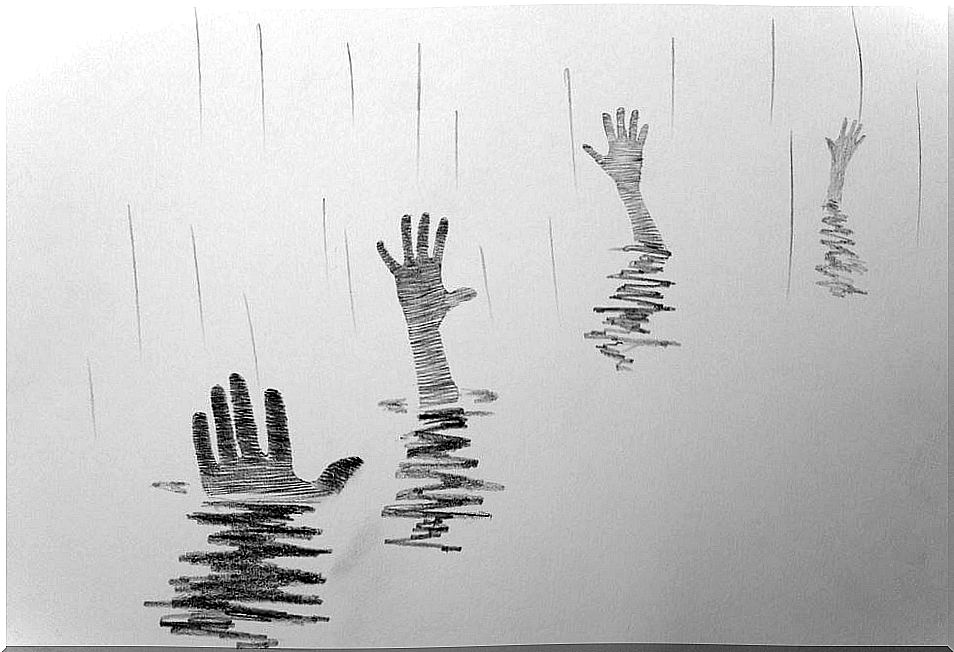Why Do We Fall Into Emotional Dependency?

We are all dependent. We are from the moment our lives begin. We are so in the womb of our mothers, in our first cries, in the first falls, during the first expeditions through unknown worlds. We are in the practical section and in the emotional section. We need others to do activities for us, or at least give us some indications to know how to do them. We also need others because we are social beings and… above all emotional. So, are we necessarily victims of emotional dependency?
There is nothing that can cause us such a whirlwind of emotions as a human being. Think of the first kiss, of a reunion of years of separation, of a hug that finally calms you down. Breathe, breathe, breathe.
When we pass adolescence, after trying to conquer our independence “tooth and nail”, we usually realize that this is not possible beyond constituting a utopia that does not necessarily have to be good, because our most basic needs do not necessarily respond to her. Think of love, of affection, even of encounters or misunderstandings.

Emotional dependence: a fact or some chains
So if emotional dependence is natural, why in psychology is it an ogre to be banished? Partly because psychology does not stop drinking from social currents and these are increasingly individualistic. Partly because this dependence turns negative when it looks at a specific person who is not us. When we give another the responsibility of dealing with the whims and desires of the child and the young person within us, and we think that that other is irreplaceable.
Let’s look at a simple example. Ana is making some changes in the decoration of her house and would like to change a piece of furniture. She is too heavy to carry on her own, so she needs someone’s help. You can be your own, studying physics and mechanics and building a jack with wheels to help you with that purpose. However, this solution is temporarily not very profitable for her.
The most profitable thing is that people stronger than her did it. Ana thinks about her children, but it turns out that they cannot because they are on vacation that week. Then he asks his nephews for help and these delighted ones do him the favor. Well, Ana is dependent, but she is not dependent on her children. If they cannot, he is able to seek help from another person. Well, the same thing happens with emotional independence / dependence.
This becomes dangerous when it is fixed on a single person and the responsibility of our emotional state is placed on them. It is dangerous because it weakens us and because it ends the relationship in the long run. However, the worst thing is that, before that relationship ends, we will have destroyed ourselves using all kinds of desperate measures so as not to lose that person in whom we have deposited the fate of our happiness.
The four steps of emotional dependence
The path of emotional destruction – due to emotional dependence – usually has four marked steps, which we begin to descend when the fear of loss appears. A fear that most of the time is unfounded and that precisely contributes to making this dependence stronger.

The first step consists, for the dependent person, in trying to make himself essential for the person on whom he depends. In showing him everything that he contributes to his life, in uploading these contributions and emphasizing them: “If it weren’t for me …”, “Let’s see who would do this to you like this …”, “You can go look around, but you won’t find anyone who does it to you like me ”.
The clerk can also try to become a guarantee, a kind of insurance, “if you continue with me, this will never fail you” and we seek that the other, even if it is by reciprocity, stays with us.
We go down to the second step when the first does not work. In addition, this second can continue to be combined with the first. In this step the dependent person disguises himself as a victim and tries to give pity. In his life, the daily ailments become real tragedies that would make the other inhuman if he wanted to get away … precisely in those moments. In addition, this is usually a strategy that the dependent knows very well since it is likely that they have used it before to claim care.
The third and fourth steps are paradigmatic and with them the dependent person tries to protect himself from what he fears the most, indifference. These two steps are interchangeable and one does not necessarily occur before the other, or both.
In addition, both refer to primary emotions: one to hatred, the other to fear. Faced with the fear of indifference, the dependent person may seek that the other hates him. It is a form of self-deception with which it seeks that there are feelings that are maintained, ties of connection, presence in the life of the other … even raising hatred.
The fourth step is that of threat. “If it occurs to you to leave, I don’t know what I can do”, “If you disappear, I have no reason to continue living”, “If you decide to leave, I assure you that you will never see me again”, “Then don’t cry, when you no longer this”. It is the fear of loss that the dependent person tries to infect the other. This fear is a deception, but for the dependent it can work perfectly as a substitute for love.
The dependent person causes suffering … and suffers
In one way or another, for the dependent, his own dependence is often torture. If he is a victim of something, it is because he has entrusted his destiny and his hopes to someone. This forces her to immolate herself so that someone does not leave, because she truly feels that if she leaves, she will lose her life. Many of his phrases are manipulation, but underneath them there is a suffering that is real.
Unfortunately emotional dependence is difficult to admit. Labels such as low value, weakness of character, and even intellectual disability are associated with it. However, identifying this dependency is the first step to rebuild it and understand that, although our needs are unique, the people who can satisfy them are various and also usually in very different ways.









